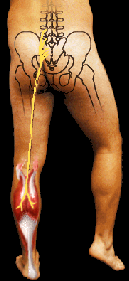
The condition manifests itself when the sciatic nerve is stretched, irritated, pinched, or impinged upon. The most common sites of nerve impingement are the vertebral foramen where the nerve exits the protection of the vertebrae in the low back and in the gluteal musculature where the piriformis muscle passes over the nerve. Symptoms may vary from sudden electric sensations (usually associated with a stretched nerve) to dull burning sensations and/or numbness. The symptoms are usually experienced in the gluteal region, posterior thigh and leg, and often include the foot. There may also be muscle weakness in the back of the thigh, in the leg, or foot. Often, only one side is affected. When both sides are affected, it is usually to varying degrees with one side much worse.
Temporary relief can often be obtained by flexing and abducting the affected side at the thigh and pointing the toes outward. This is accomplished by lying on the back with the foot of the affected leg propped up and slightly away from the body with the toes pointing outward. While standing, this can be accomplished by putting the foot of the affected leg on a low step stool slightly off to the side with the toes pointing outward.
About the Sciatic nerve
The sciatic nerve is the largest and thickest nerve in the body. It leaves the spinal column primarily between L4, 5, S1, 2, and 3. Near the knee, it splits into two large divisions, the tibial and common peroneal nerves.
Different Causes or Sciatica
If the cause of sciatica is a prolapse of the intervertebral disk, coughing or sneezing might dramatically increase the pain symptoms. Mal-alignment or mal-function of the vertebral joints may cause a change in the normal function of the nerve. Bony arthritic changes may affect the size of the opening where the nerve leaves the spine. This may “pinch” or irritate the nerve. A sprained or strained muscle or ligament, or a muscle spasm may affect the course of the nerve. A sudden trauma, such as an automobile accident, may damage tissues such as the vertebral joints. A cumulative trauma, such as repetitive motions that irritate the area or long hours of sitting can affect the surrounding tissues of the nerve and hinder normal nerve function. Rarely, an abnormal growth or condition along the course of the nerve may interfere with its normal function causing the syndrome.
Treatments for Sciatica
Treatments for sciatica range from conservative chiropractic adjustments to surgery. The goal in treating the condition is to remove the interference and normalize nerve transmission.
Chiropractic adjustments align the bones of the spine and improve joint function. This often normalizes the surrounding tissues and removes nerve interference. Chiropractic adjustments may help even in the presence of bony arthritic spurs or herniated discs. Low back traction or massage of the lumbar, gluteal, and posterior thigh musculature may produce results.
As a more aggressive approach, the orthopedic surgeon may choose to remove the offending tissues. There is a host of intermediate treatments that treat the symptoms rather than the cause. If inflammation is involved, non-steroidal anti-inflammatory drugs are often used. While this may help, the cause of the inflammation will likely need to be addressed to prevent a recurrence of the inflammation and the syndrome. If muscle relaxants benefit, the cause of the muscle spasms may need to be addressed. Otherwise, when the drugs wear off, the symptoms are likely to return. Over the counter pain relievers may also provide some temporary relief, however, they do not treat the cause and may have side effects. Ice packs on the low back where the nerves exit the spine often provide relief. Ice packs should not be used more than 1 time in an hour for a maximum of 15 minutes at a time. Ice packs, however, will not address the cause, but rather, simply treat the symptoms. Transcutaneous electrical nerve stimulation (T.E.N.S.) may provide relief of pain (though not treat the cause). If the cause is an abscess, infection, tumor, or blood clot, medical treatment is needed.
Alternative Sciatica Treatments
Alternative sciatic treatments include acupuncture and acupressure.
Dr. Michael Haley has been helping people with sciatica in Pompano Beach and Fort Lauderdale since 1996.
The information presented is not intended to replace sound chiropractic or medical treatment.
Agape Chiropractic
500 S. Cypress Road #4
Pompano Beach, Florida 33060
(954) 545-9750
9/2000
You must be logged in to post a comment.